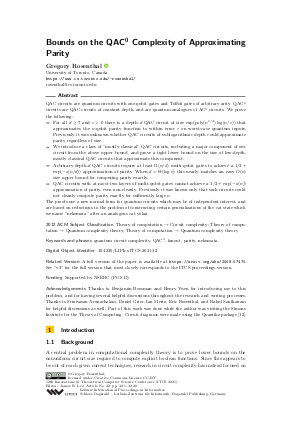Bounds on the QAC^0 Complexity of Approximating Parity
Author
Gregory Rosenthal 
-
Part of:
Volume:
12th Innovations in Theoretical Computer Science Conference (ITCS 2021)
Part of: Series: Leibniz International Proceedings in Informatics (LIPIcs)
Part of: Conference: Innovations in Theoretical Computer Science Conference (ITCS) - License:
 Creative Commons Attribution 3.0 Unported license
Creative Commons Attribution 3.0 Unported license
- Publication Date: 2021-02-04
File

PDF
LIPIcs.ITCS.2021.32.pdf
- Filesize: 0.52 MB
- 20 pages
Document Identifiers
Related Versions
-
A full version of the paper is available at https://arxiv.org/abs/2008.07470. See "v3" for the full version that most closely corresponds to the ITCS proceedings version.
Subject Classification
ACM Subject Classification
- Theory of computation → Circuit complexity
- Theory of computation → Quantum complexity theory
- Theory of computation → Quantum complexity theory
Keywords
- quantum circuit complexity
- QAC^0
- fanout
- parity
- nekomata
Metrics
- Access Statistics
-
Total Accesses (updated on a weekly basis)
0Document
0Metadata
Abstract
QAC circuits are quantum circuits with one-qubit gates and Toffoli gates of arbitrary arity. QAC^0 circuits are QAC circuits of constant depth, and are quantum analogues of AC^0 circuits. We prove the following:
- For all d ≥ 7 and ε > 0 there is a depth-d QAC circuit of size exp(poly(n^{1/d}) log(n/ε)) that approximates the n-qubit parity function to within error ε on worst-case quantum inputs. Previously it was unknown whether QAC circuits of sublogarithmic depth could approximate parity regardless of size.
- We introduce a class of "mostly classical" QAC circuits, including a major component of our circuit from the above upper bound, and prove a tight lower bound on the size of low-depth, mostly classical QAC circuits that approximate this component.
- Arbitrary depth-d QAC circuits require at least Ω(n/d) multi-qubit gates to achieve a 1/2 + exp(-o(n/d)) approximation of parity. When d = Θ(log n) this nearly matches an easy O(n) size upper bound for computing parity exactly.
- QAC circuits with at most two layers of multi-qubit gates cannot achieve a 1/2 + exp(-o(n)) approximation of parity, even non-cleanly. Previously it was known only that such circuits could not cleanly compute parity exactly for sufficiently large n.
The proofs use a new normal form for quantum circuits which may be of independent interest, and are based on reductions to the problem of constructing certain generalizations of the cat state which we name "nekomata" after an analogous cat yōkai.
Cite As Get BibTex
Gregory Rosenthal. Bounds on the QAC^0 Complexity of Approximating Parity. In 12th Innovations in Theoretical Computer Science Conference (ITCS 2021). Leibniz International Proceedings in Informatics (LIPIcs), Volume 185, pp. 32:1-32:20, Schloss Dagstuhl – Leibniz-Zentrum für Informatik (2021)
https://doi.org/10.4230/LIPIcs.ITCS.2021.32
BibTex
@InProceedings{rosenthal:LIPIcs.ITCS.2021.32,
author = {Rosenthal, Gregory},
title = {{Bounds on the QAC^0 Complexity of Approximating Parity}},
booktitle = {12th Innovations in Theoretical Computer Science Conference (ITCS 2021)},
pages = {32:1--32:20},
series = {Leibniz International Proceedings in Informatics (LIPIcs)},
ISBN = {978-3-95977-177-1},
ISSN = {1868-8969},
year = {2021},
volume = {185},
editor = {Lee, James R.},
publisher = {Schloss Dagstuhl -- Leibniz-Zentrum f{\"u}r Informatik},
address = {Dagstuhl, Germany},
URL = {https://drops.dagstuhl.de/entities/document/10.4230/LIPIcs.ITCS.2021.32},
URN = {urn:nbn:de:0030-drops-135713},
doi = {10.4230/LIPIcs.ITCS.2021.32},
annote = {Keywords: quantum circuit complexity, QAC^0, fanout, parity, nekomata}
}
Author Details
Funding
Supported by NSERC (PGS D).
Acknowledgements
Thanks to Benjamin Rossman and Henry Yuen for introducing me to this problem, and for having several helpful discussions throughout the research and writing processes. Thanks to Srinivasan Arunachalam, Daniel Grier, Ian Mertz, Eric Rosenthal, and Rahul Santhanam for helpful discussions as well. Part of this work was done while the author was visiting the Simons Institute for the Theory of Computing. Circuit diagrams were made using the Quantikz package [Kay, 2020].
References
-
Noga Alon and Joel Spencer. The Probabilistic Method. Wiley Series in Discrete Mathematics and Optimization. John Wiley & Sons, 4 edition, 2016.

- Adam Bene Watts, Robin Kothari, Luke Schaeffer, and Avishay Tal. Exponential separation between shallow quantum circuits and unbounded fan-in shallow classical circuits. In Symposium on the Theory of Computing, pages 515-526, 2019. URL: https://doi.org/10.1145/3313276.3316404.
- Debajyoti Bera. A lower bound method for quantum circuits. Information Processing Letters, 111(15):723-726, 2011. URL: https://doi.org/10.1016/j.ipl.2011.05.002.
- Debajyoti Bera, Frederic Green, and Steven Homer. Small depth quantum circuits. ACM SIGACT News, 38(2):35-50, 2007. URL: https://doi.org/10.1145/1272729.1272739.
- Maosen Fang, Stephen Fenner, Frederic Green, Steven Homer, and Yong Zhang. Quantum lower bounds for fanout. Quantum Information & Computation, 6(1):46-57, 2006. URL: http://arxiv.org/abs/quant-ph/0312208.
- Dmitry Gavinsky, Shachar Lovett, Michael Saks, and Srikanth Srinivasan. A tail bound for read-k families of functions. Random Structures & Algorithms, 47(1):99-108, 2015. URL: https://doi.org/10.1002/rsa.20532.
- Pranav Gokhale, Samantha Koretsky, Shilin Huang, Swarnadeep Majumder, Andrew Drucker, Kenneth R. Brown, and Frederic T. Chong. Quantum fan-out: circuit optimizations and technology modeling. arXiv, 2020. URL: http://arxiv.org/abs/2007.04246.
- Frederic Green, Steven Homer, Cristopher Moore, and Christopher Pollett. Counting, fanout, and the complexity of quantum ACC. Quantum Information & Computation, 2(1):35-65, 2002. URL: http://arxiv.org/abs/quant-ph/0106017.
- Andrew Y. Guo, Abhinav Deshpande, Su-Kuan Chu, Zachary Eldredge, Przemyslaw Bienias, Dhruv Devulapalli, Yuan Su, Andrew M. Childs, and Alexey V. Gorshkov. Implementing a fast unbounded quantum fanout gate using power-law interactions. arXiv, 2020. URL: http://arxiv.org/abs/2007.00662.
- Johan Håstad. Almost optimal lower bounds for small depth circuits. In Symposium on the Theory of Computing, pages 6-20, 1986. URL: https://doi.org/10.1145/12130.12132.
- Peter Høyer and Robert Špalek. Quantum fan-out is powerful. Theory of Computing, 1(5):81-103, 2005. URL: https://doi.org/10.4086/toc.2005.v001a005.
- Alastair Kay. Tutorial on the Quantikz package, 2020. URL: https://doi.org/10.17637/rh.7000520.
- Daniel Padé, Stephen Fenner, Daniel Grier, and Thomas Thierauf. Depth-2 QAC circuits cannot simulate quantum parity. arXiv, 2020. URL: http://arxiv.org/abs/2005.12169.
- Yasuhiro Takahashi and Seiichiro Tani. Collapse of the hierarchy of constant-depth exact quantum circuits. Computational Complexity, 25(4):849-881, 2016. URL: https://doi.org/10.1007/s00037-016-0140-0.
